As Electronic Arts got off the ground, Trip Hawkins hired three veterans from his time at Apple — Dave Evans, Pat Marriott, and Joe Ybarra — to become the first people with the job title of “producer” at EA. Their new careers began with a mock draft: Hawkins had them draw lots to determine the order in which they would get to pick the developers they would be working with. Naturally, the three experienced developers all went in the first round, and in the order of their status within established gaming circles. Evans picked first, and chose Bill Budge, the first and arguably still the greatest of the Apple II’s superstar game developers, with name recognition within that community that could be matched by very few others. Marriott chose next, and picked Free Fall Associates, whose Jon Freeman had been responsible for the landmark CRPG hit Temple of Apshai and the Dunjonquest line of sequels and spinoffs that had followed it from Automated Simulations. That left Ybarra with Dan Bunten and his new team Ozark Softscape.
Unlike the others, Bunten had no hits on his resume; his biggest game to date had sold all of 6000 copies. He had previously published through Strategic Simulations, Incorporated, which was the antithesis of Hawkins’s vision of casual consumer software, having been founded by a grognard named Joel Billings to release a series of almost aggressively off-putting computer wargames in the hardcore tabletop tradition. Still, Hawkins had fallen in love with one of Bunten’s SSI games, a business simulation called Cartels and Cutthroats. He had first tried to buy it outright from Billings. When his overtures were rejected, he turned to Bunten himself to ask if he would like to make a game kind of like it for EA. Thus the presence of this B-lister on EA’s rolls, complete with generous royalty and advance. To make things even worse, Ozark was located, as the name would imply, deep inside flyover country: Little Rock, Arkansas. Ybarra certainly didn’t relish the many trips he would have to make there. Little did he realize that the relationship would turn into one of the most rewarding of his career, or that the first game he would develop with Ozark, M.U.L.E., would become the most beloved of all the early titles inside the company, or that it would go on to be remembered as one of the greatest of the all-time classic greats.
Dan Bunten was an idealist from an early age. At university he protested the Vietnam War, and also started a bicycle shop, not to make money but to help save the world. According to his friend Jim Simmons, Bunten’s logic was simple: “If more people rode bikes, the world would be a better place.” When he watched Westerns, Bunten was an “Indian sympathizer”: “It just seems like such a neat, romantic culture, in tune with the earth.” A staunch anti-materialist, he drove a dented and battered old Volkswagen for years after he could afford better. “I felt like I sold out when I bought a 25-inch color TV,” he said. That 1960s idealism, almost quaint as it now can sound, became the defining side of Bunten the game designer. He campaigned relentlessly for videogames that brought people together rather than isolating them. As his most famous quote, delivered at an early Game Developers Conference, went, “No one on their death bed ever said, ‘I wish I had spent more time alone with my computer!'” M.U.L.E. positively oozes that idealistic sentiment. As such, it’s an easy game to fall in love with. Certainly your humble blogger here must confess to being a rabid fanboy.
The seeds of M.U.L.E. were planted back in 1978 when Bunten bought his first Apple II. Educated as an industrial engineer, he at that time was 29, married and with daughter, and seemingly already settled into running a consulting firm doing city planning under a National Science Foundation grant in Little Rock. The eldest of six children, Bunten and his siblings had played lots of board games growing up: “When I was a kid the only times my family spent together that weren’t totally dysfunctional were when we were playing games.” In fact, some of his fondest childhood memories had taken place around a Monopoly board. Dan and his brother Bill had also delved into the world of wargames; when the former was twelve and the latter ten they had designed a complete naval wargame of their own, drawing the map directly onto the basement floor. During a gig working at the National Science Foundation, he had spent some of his time tinkering on their Varian minicomputer with an elaborate football simulation he imagined might eventually become the heart of a Master’s thesis in systems simulation. Now he started working on a game for the Apple II. Right from the beginning his approach to game design was different from that of just about everyone else.
Bunten loved more than anything the social potential of gaming. Setting a precedent that would endure for the rest of his career, he determined to bring some of that magic to the computer. Working in BASIC with only 16 K, he wrote a simple four-player auction game called Wheeler Dealers. He designed a simple hardware gadget to let all four players bid at once. (The details of how this worked, as well as the game software, unfortunately appear to be lost to history.) Then he found a tiny Canadian mom-and-pop publisher called Speakeasy Software to sell the game and the gadget for $54. (Speakeasy’s founder Brian Beninger: “Dan called out of the blue one day and spoke to Toni [Brian’s wife]. She had never experienced an accent from the southern United States and had trouble understanding him…”) Legend has it that Wheeler Dealers was the first computer game ever sold in a box, a move necessitated by the inclusion of the hardware gadget. However, such a claim is difficult to substantiate, as other games, such as Temple of Apshai and Microsoft Adventure, were also beginning to appear in boxes in the same time frame. What is certain is that Bunten and Speakeasy took a bath on the project, managing to sell just 50 to 150 (sources vary) of the 500 they had optimistically produced. In retrospect that’s unsurprising given the game’s price and the limited reach of its tiny publisher, not to mention the necessity of gathering four people to play it, but it did set another, unfortunate precedent: Wheeler Dealers would not be the last Bunten game to commercially disappoint.
Still, Bunten had caught the design bug. For his next project, he dusted off the FORTRAN source to his old football simulation. As would befit a Master’s thesis project, that game was the “most thoroughly mathematically modeled” that he would ever do, the deepest he would ever delve into pure simulation. It was, in other words, a great fit for the hardcore grognards at SSI, who released Computer Quarterback as one of their first titles in an all-text version in 1980, followed by a graphical update that took advantage of the Apple II’s hi-res mode in 1981. Typically for SSI, the manual determinedly touts Bunten’s professional credentials in an attempt to justify him as a designer of “adult games.” There is even affixed his seal as a “State of Arkansas Registered Professional Engineer”:
By affixing my seal hereto, I certify that this product was developed in accord with all currently accepted techniques in the fields of operations research, systems simulation, and engineering design, and I further accept full responsibility for the professional work represented here.
It all seems a bit dreary, and an especially odd sentiment from a fellow who would become known for championing easy accessibility to everyday people in his designs. Yet simulation of the real world was in fact a deep, abiding fascination of Bunten, albeit one that would be more obscured by his other design tendencies in his later, mature games. In the meantime, SSI’s audience of the hardcore was big enough to make Computer Quarterback Bunten’s bestselling game prior to his signing with EA, the one that convinced him to quit his day job in city planning and dive into game development full time. Indeed, the aforementioned figure of 6000 sold at the time of EA’s founding would continue to increase afterward; SSI would continue to sell updated versions well into the late 1980s.
Bunten’s next game was the one that caught Hawkins’s eye, Cartels and Cutthroats. Like Hawkins of the “Strategy and Applied Game Theory” degree, Bunten was fascinated by economic simulations. For help with the modeling of Cartels, an oddly abstracted simulation of the business world — you are told in the beginning only that your company produces either “luxury,” “mixed,” or “necessity goods” — he turned to his little brother Bill, who had recently finished his MBA. Apparently few other gamers of the time shared Hawkins’s and Bunten’s interest in economic simulation; Cartels did not even manage the sales that Computer Quarterback had. Bunten later wryly noted that “evidently folks interested in playing with the stock market or business, do it in real-life instead.” That may to some extent be true, but in my opinion the game’s abstractions do it no favors; it’s hard to get excited about your role as producer of a “luxury good.” Cartels today reads as a step on the road to M.U.L.E.. The later game would continue the economics focus while grounding itself in a much more specific context that the player can really get her hands around.
If these early SSI games can seem slightly anomalous to Bunten’s mature work in their unabashed focus on simulation, one thing did stay consistent: they were conceived primarily as multi-player affairs. SSI had to cajole him into putting together a rudimentary opponent AI and single-player mode for Computer Quarterback as a condition of acceptance for publication. Bunten named the computer’s team “The Robots,” which perhaps shows about how seriously he took them. Cartels and Cutthroats offers a number of ways for up to six people to play together, the most verisimilitudinous of which employs a printer to let each player grab her stock reports off the “teletype.” Here computer players, while once more optionally present, still don’t get no respect: now they are called “dummies.”
Bunten’s final game for SSI was a marked departure. Released on SSI’s short-lived Rapid Fire line of action-oriented titles, Cytron Masters plays like a prototype of the real-time strategy games that would become popular a decade later. Two players — the two-player mode was again the main focus; the computer opponent’s AI was predictably atrocious — face off on a battlefield of the future in real time, spawning and issuing orders to six types of units. Each player can have up to fifty units onscreen at once, all moving about semi-autonomously. Bunten’s first game to use large amounts of assembly-language code as opposed to BASIC, it was by far his most challenging programming project yet. Cytron had to juggle animations and sound effects while also running the simple AI routines for up to a hundred on-screen units and accepting input from two players, all without becoming so slow as to lose its status as an “action-strategy” game. This presented a huge challenge on the minimalist, aging hardware of the Apple II. As Bunten wrote in a Computer Gaming World article about the experience, “the Apple can’t do two things without a lot of effort (you have to time your clicks of the speaker with your graphic draw routine so that they take turns). It was a tough program to write [emphasis original].”
By this time the Atari 800 was almost three years old, and Bunten had had one “collecting dust” for a pretty good portion of that time. He had remained committed to the Apple II as both the machine with the healthiest software market and the one he knew how to make “sing.” But now he decided to have a go at porting Cytron Masters to the 800. The experience proved to be something of a revelation. At first Bunten expected to just duplicate the game on the Atari. But when he showed the first version to Atari users, they scoffed. “It’s a neat game, but where’s the color? And what are those little noises?” they asked in response to the explosions.
Needless to say, I decided that if the program was to do well as an Atari version, it would have to use a few of the features of that machine. But, during the conversion, I discovered that all the sophisticated hardware features of the Atari are useful! Cytron Masters uses the separate sound processor and four voices to make truly impressive sound effects (at least compared to the Apple); it uses the display list and display-list interrupts to change colors on the fly, and have character graphics, four-color text as well as hi-res graphics on one screen; it uses player/missile graphics for additional colors and fast animation; and most useful of all, it uses vertical-blank interrupts to allow two programs to (apparently) run at once!
Bunten became the latest of a long line of programmers to fall for the elegance of Jay Miner’s Atari 8-bit design, an elegance which the often developer-hostile antics of Atari itself could obscure but never quite negate. He would never develop another game on the Apple II, and the company he was already in the process of forming, Ozark Softscape, would be an Atari shop. (M.U.L.E. never even got a port to the Apple II.)
Cytron Masters was another relative commercial disappointment for Bunten and SSI. “Rather than appealing to both action gamers and strategy gamers,” he later said, “it seemed to fall in the crack between them.” But then, just as Bunten was finishing up the Atari port, Trip Hawkins came calling asking for that sequel to Cartels and Cutthroats and promising that EA could find him the commercial success that had largely eluded his SSI games.
By this point Bunten was already in the process of taking what seemed to him the next logical step in his new career, going from a lone-wolf developer and programmer to the head of a design studio. In a sense, Ozark Softscape was just a formalizing of roles that already existed. Of the three employees that now joined him in the new company, his little brother Bill had already helped a great deal with the design of Cartels and Cutthroats while also serving as a business adviser; Jim Rushing, a friend of Bill’s from graduate school, had offered testing and occasional programming input since the same time; and Alan Watson, formerly a salesman at a local stereo shop, had helped him with the technical intricacies of Cytron Masters and contributed his talents for Atari graphics programming to the port. Now the three came to Ozark largely in the roles they had already carved out. Bill Bunten, the only one to keep his day job (as a director of parks for the city of Little Rock) and the only non-programmer, would handle the administrative vagaries of running a business. Rushing would program, as would Watson in addition to serving as in-house artist. All three would offer considerable design input as well, but they all would ultimately defer to Dan, the reason they were all here. As Rushing later said, “We all knew Dan was a genius.” They were just happy to be along for the ride.
With their EA advance they rented a big house across the street from the University of Arkansas to serve as office, studio, and clubhouse. Each took a bedroom as an office, and they filled the living room and den with couches, beanbag chairs, and of course more computers, making of them ideal spaces for brainstorming and playing. They filled the huge refrigerator in the kitchen with beer, which helped to lure in a crowd of outsiders to play and offer feedback virtually every evening. These were drawn mostly from the biggest local computer club, the Apple Addicts, of which Dan had been the first president back in the days of Wheeler Dealers. He may have defected to the Atari camp since, but no one seemed to mind; at least one or two were inspired by what they saw in the house to buy Ataris of their own. When they grew tired of creating and playing, the house’s regular inhabitants as well as the visitors could exit the back door to walk around an idyllic fourteen-acre lake, to sit under the trees talking or skip rocks across the water. The house and its environs made a wonderful space for creation as well as an ideal laboratory for Dan’s ideas about games as social endeavors to bring people together. It was here that Dan and his colleagues took M.U.L.E. from the germ of a concept to a shipping game in less than nine months.
Said germ was to create a game similar to the rather dryly presented, text-based Cartels and Cutthroats, only more presentable and more accessible, in line with Trip Hawkins’s credo of “simple, hot, and deep” consumer software. They would be writing for the Atari 8-bit line, which in addition to excellent sound and graphics offered them one entirely unique affordance: these machines offered four joystick ports rather than the two (or none) found on other brands. Dan thus saw a way to offer in practical form at last the vision that had caused him to get involved with game design in the first place back in the days of Wheeler Dealers. Four people could gather around the living room, each with her own controller, and really play together, in real time; no need for taking turns in front of the computer or any of the other machinations that had marked his earlier games. This would allow him to create something much breezier than Cartels and Cutthroats — a game to replace the old board-game standbys on family game nights, a game for parties and social occasions. With the opportunity to do those Wheeler Dealers real-time auctions right at last, Dan dusted the old idea off and made it the centerpiece of the new design.
Given their intention to create a family board game for the next generation, Dan and his colleagues started to look at the classic designs for other ideas with which to surround the auctions. The obvious place to look for inspiration for a game with an economic theme was the game that is still pretty much the board game as far as the masses are concerned: Monopoly. Monopoly gets a lot of grief amongst hardcore gamers these days for a multitude of very real flaws, from an over-reliance on luck in the early stages to the way it often goes on forever after it becomes totally obvious who is going to win to the way it can leave bankrupted players sitting around with nothing to do for an hour or more while everyone else finishes. Yet there’s something compelling about it as well, something more than sheer cultural inertia behind its evergreen appeal. The team now tried to tease out what those qualities were. Bill Bunten said, half facetiously, that his favorite thing about Monopoly was the iconic metal tokens representing each player — the battleship, the car, the top hat, the shoe, etc. Everyone laughed, but the input became an important part of the new game’s charm: every player in it gets to pick the avatar she “most resembles.”
Looking more deeply for the source of Monopoly‘s appeal, the team realized that it was socially- rather than rules-driven. Unlike most board games, which reward the analytical thinker able to maximize the interactions of a rules set, Monopoly — at least if you’re playing it right — rewards the softer arts of negotiation and diplomacy. The personalities of the players and the relationships among them have as much effect on the way play proceeds as do the rolls of the dice. In the Bunten family, Mom would always let you out of paying rent if you couldn’t afford it; Bill would force you to mortgage a property if you came up a dollar short on your rent. Alliances and partnerships would form and shift as a result. The team decided that they wanted that human element in their game. It had never been seen in a computer game before, for the very simple reason that it was beyond the scope of possibility for an AI opponent living in 48 K of memory. But in their game, conceived primarily as a multi-player experience, it should be possible.
And yet more elements were drawn from Monopoly. Play would center around a “board” of properties which would be gradually acquired by the players, through a land grant that began each turn or through auctions or trades. They also built in equivalents to Monopoly‘s Chance and Community Chest cards to keep play from getting too comfortable and predictable. In keeping with Dan’s roots in simulation, however, the game would attempt to model real economic principles, making its theme more than just the window-dressing it largely was in Monopoly. Producing the same good in two adjacent plots would let the player take advantage of economies of scale to produce more; having three plots in total producing the same good would also result in more production, thanks to the learning curve theory of production. In general, the computer allowed for a deeper, more fine-grained game model than was possible in dice and cardboard. For instance, normalized probability curves could be used in place of a six-sided die, and the huge sums of money the players would eventually accumulate could be tracked down to the dollar. It all would result in something more than just a computerized board game. It would be a real, functioning economy, a modest little virtual world where the rules of supply and demand played out transparently, effortlessly from the players’ perspective, just as they do in the real world.
But what should be the fictional premise behind the world? For obvious commercial reasons — Star Wars and Star Trek were huge in the early 1980s — they decided early on to give the game a science-fiction theme. Dan and Bill had both read Time Enough for Love by Robert Heinlein. Dating from the early stages of Heinlein’s dirty-old-man phase, there’s not much to recommend the book if you aren’t a fan of lots and lots of incestuous sex written in that uniquely clunky way of aging science-fiction writers who look around to realize that something called the Sexual Revolution has happened while they were hanging out at science-fiction conventions. Still, the brothers were inspired by one section of the book, “The Tale of the Adopted Daughter,” about a colony that settles on a distant planet. Provided with only the most meager materials for subsistence, they must struggle to survive and build a functioning economy and society by the time the colony ship returns years later to deliver more colonists and, more importantly, haul away the goods they produced to make a profit for everyone back in the more civilized parts of the galaxy. Sounds like a beautiful setup for a game, doesn’t it? To add a realistic wrinkle, the team decided that each of the four players would not only be working for herself, but must balance self-interest with the need to make the colony as a whole successful by the time the ship returned. Thus entered the balancing act people working in real economies must come to terms with, between self-interest and the needs of the society around them. A player who gets too cutthroat in her attempts to wring every bit of profit out of the others can bring the whole economy crashing down around her ears. (Perhaps some banking executives of recent years should have played more M.U.L.E. as youngsters.)
Among the most valuable tools that Heinlein’s colonists bring with them is a herd of genetically modified mules that are not only possessed of unusual strength and endurance but also so intelligent that they can engage in simple speech. The fact that the mules are nevertheless bought and sold like livestock makes this just one more squicky aspect of a very squicky book; it feels uncomfortably like slavery. Obviously that wouldn’t quite do for the game. Then one day Alan Watson’s son came in with a toy model of an AT-AT Walker from The Empire Strikes Back. It only took the removal of the guns and the addition of a listlessly shambling gait to go from Imperial killing machine to cute mascot. A hasty backronym was created: mules were now M.U.L.E.s, Multi-Use Labor Elements programmable to perform any of several different roles. They provided the pivot around which the whole experience would revolve.
He [a M.U.L.E.] was born — if you can call it that — in an underground lab in the Pacific Northwest. A major defense contractor had gone out of its way to get the job and they were stoked.
Stoked, this is, until the detailing robots went on strike. Costs ran over. Senators screamed. And when the dust had cleared, the job was finished by a restaurant supply firm, a maker of preschool furniture, and the manufacturers of a popular electric toaster.
It shows.
The game itself was quickly renamed from the underwhelming Planet Pioneers to M.U.L.E., albeit not without some conflict with EA, who pushed for the name Moguls from Mars. Thankfully, M.U.L.E. won the day in the end.
Combined with the Monopoly-inspired player avatars, the M.U.L.E.s anchored the game in a concrete reality, offering it an escape from the abstraction that had limited the appeal of Cartels and Cutthroats. Now the player could be embodied in the economic simulation. She didn’t just assign one of her plots to produce, say, smithore (the colony’s main cash crop, which requires food and energy to produce) from some textual display. No, she had to walk into the village at the center of the colony, buy a M.U.L.E., outfit it for the right sort of work, then lead it back to her plot. And now auctions could be implemented as a unique combination of footrace and game of chicken involving all of the players’ avatars. All of this is done entirely with the joystick, forming a GUI interface of sorts perfectly in line with Trip Hawkins’s vision of a new generation of friendly consumer software. The new “visual, tactile relationship” (producer Joe Ybarra’s words) between player and game also allowed some modest action elements to keep players on their toes: they had only a limited amount of time to try to accomplish everything they needed to — buying M.U.L.E.s, reequipping and rearranging them to suit current production needs, etc. — during their turn. Running out of time or misplacing a M.U.L.E. (thus causing it to run off) could be disastrous; conversely, working quickly and efficiently, and thus finishing early, gave time to earn some extra money by gambling in the pub, or, in an homage to Gregory Yob’s classic, go hunting for the “mountain wampus.” The latter was just one of many elements of whimsy the team found room to include, one more drop in M.U.L.E.‘s bucket of charm.
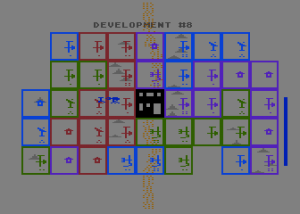
Leading a M.U.L.E. from the village at the center of the game board for placement in an empty plot (denoted by the house symbol) at far left.
With the core ideas and mechanics now in place, Dan Bunten and his colleagues had the makings of one hell of a game on their hands. But as any good game designer, whether she works in cardboard or silicon, will tell you, even the most genius of designs must be relentlessly tested, endlessly tweaked. Ozark Softscape and EA devoted literally months to this task, gradually refining the design. Land had originally all been sold through auctions, but this soon became obviously problematic: once a player got fairly well ahead, she would be able to buy up every plot that became available, putting her economy in a different league from everyone else’s and making the outcome a foregone conclusion as early as halfway through the game. They solved this by automatically granting one plot of land to each player on every turn, only supplementing those grants with the occasional plot that came up for auction. They also added several other little tweaks designed to keep anyone from completely running away with the game. For instance, a bad random event can never happen to the player in last place, while a good can never happen to the player in first. In case of ties in auctions or land grants — two or more players arriving somewhere or pressing their buttons at the same time — priority always goes to the player furthest behind.
And then of course the economy itself — the exact relationship between supply and demand, the prices of the different commodities and the ways they fluctuated — required a multitude of adjustments to find the perfect balance.
The game was designed to always have four players, with the seats of any absent humans being filled by computer opponents. This required the development of AI. While obviously not the main point of M.U.L.E., the team to their credit did a pretty good job with that; the computer often makes smarter moves than you might expect. Single-player M.U.L.E. is a pale shadow of multi-player M.U.L.E., but it’s hardly a disaster. (As Dan later wrote, “Single-player M.U.L.E. is considerably better than single-player Monopoly!”) It’s even possible to let four computer opponents play while you sit back and watch, something that stores looking to feature the game in their sales windows must have greatly appreciated.
Ozark relied for all of the exhaustive and exhausting testing required to get everything right not only on the endless stream of eager players who visited their house each night but also on others back at EA. Both Hawkins and Ybarra made considerable contributions to the design. Hawkins pushed always to make M.U.L.E. as realistic an economic simulation as its premise and the need for accessibility — not to mention the limited capabilities of the Atari 800 — would allow. Later he wrote the manual himself; like the game, it’s a model of concise, friendly accessibility, designed to get the player playing with an absolute minimum of tedious reading. As for Ybarra… well, here’s his level of dedication to a project of which he had started out so skeptical:
Right about the mid-point of the product, when we were starting to get [the] first playable [builds], that was when I started my several-hundred hour journey of testing this game. I can remember many nights I would come home from work and fire up the Atari 800 and sit down with my, at the time, two-year-old daughter on my lap holding the joystick that didn’t work, while I was holding the joystick that did work, testing this game. And I’d probably get eight or ten games in at night, and I would do that for two or three or four months actually, trying to work out all the kinks in the product.
By the way, at that time in the history of EA, we had no testers. In fact we had no assistance—we didn’t have anything! So producers had to do everything. I tested my own products; I built my own masters; I did all the disk-duplication work; I did all the copy-protection; I did the whole nine yards! If it was associated with getting the product manufactured, the producers did all the work. I remember a lot of nights there staying up until one or two o’clock in the morning playing M.U.L.E. and thinking, “Wow, this game is good!” It was a lot of fun. And then thinking to myself, “Gee, I wish the AI would do this.” So I took notes and took them along to Dan, and said “If you do these kinds of things at this point in the game, this is what happens.” He would take parts of those notes, and a couple of days later I’d get a new build and be back in that main chair back with my daughter on my lap, once again testing this thing and checking to see if it worked. More often than not, it did. That was a really special time.
As the game neared completion just in time for EA’s own launch as a publisher, the EA PR folks went to work. Hewing always to the “software artists” dictum, they cast Ozark Softscape as a group of hip back-country savants, sort of the gaming equivalent of the Allman Brothers Band. Their portrait on the inner sleeve of M.U.L.E. even bears a certain passing resemblance to the Allmans’ iconic At Fillmore East cover.
Like all of this software-artists stuff, it was a bit contrived. The girl Bill Bunten is apparently ogling like a real rock star on the prowl is actually his sister, hastily recruited to add an element of additional interest to the picture.
Heartbreakingly, the image-making and advertising didn’t get the job done. Despite all the love lavished on M.U.L.E. by Ozark Softscape and EA and despite deservedly stellar reviews, it was a commercial disappointment. M.U.L.E. sold only about 30,000 copies over its lifetime. By way of comparison, consider that Pinball Construction Set, another launch title, shifted over 300,000 units. Some of the disappointment may be down to M.U.L.E.‘s debuting on a relative minority platform, the Atari 8-bit line. Although it was later ported to the juggernaut Commodore 64, it was kludgier away from the Atari and its four joystick ports. Even the latest iteration of the Atari 8-bit line, the 1200XL, couldn’t play M.U.L.E. properly, thanks to Atari’s decision to reduce the four joystick ports to two in the name of cost reduction. Out of all the disappointments engendered by that very disappointing machine, this was perhaps the most painful. Thus M.U.L.E., the Atari 8-bit’s finest gaming hour, plays properly only on a subset of the line.
But likely even more significant was a fact that was slowly becoming clear, to Dan Bunten’s immense frustration: multi-player games just didn’t sell that well. It really did seem that most of the people buying computer games preferred to spend their time alone with them. Reluctantly recognizing this, even he would soon be forced by commercial concerns to switch to the single-player model, at least for a couple of games.
Yet we can take comfort in the fact that M.U.L.E.‘s reputation has grown to far exceed its commercial performance. Indeed, it’s better remembered and better loved today than all but a handful of the contemporaries that trounced it so thoroughly in the marketplace back in the day. And deservedly so, because playing M.U.L.E. with a group of friends is a sublime experience that stands up as well today as it did thirty years ago. The world is a better place because it has M.U.L.E. in it, and every time I think about it I feel just a little bit happier than I was before. Just a few notes of its theme music (written by a Little Rock buddy of the Buntens, Roy Glover) puts a smile on my face. If the reasons for that aren’t clear from all the words that have preceded these, that may be down to my failings as a writer. But it may just also be down to the way that it transcends labels and descriptions. If ever a game was more than the sum of its parts, it’s this one. I could tell you at this point how such gaming luminaries as Sid Meier, Will Wright, and Warren Spector speak about M.U.L.E. with stars in their eyes, but instead I’ll just ask you to please go play it.
There are modern re-creations on offer, but purists like me still prefer the original. In that spirit, here’s the manual and Atari disk image, which you can load into an emulator if, like most of us, you don’t have an old Atari 800 lying around. Pick up some old-time digital joysticks as well and then hook a laptop up to your television to really do the experience right. That’s the way that M.U.L.E. should be played — gathered around the living room with good friends and the snacks and beverages of your choice. At some point during the evening remember to look around and remind yourself in best beer-commercial fashion that gaming doesn’t get any better than this. And maybe drink a toast to the late, great Dan Bunten while you’re at it.
Update, August 1, 2023: The Dan Bunten of this article began to live as the woman Dani Bunten Berry in 1992; she died in 1998. I knew less about transgenderism at the time that I wrote this article than I do now, and would certainly have written it differently today. Which doesn’t, of course, mean that my handling of it would satisfy everybody. These are complicated issues, balancing fidelity to history against the rights of individuals to determine their own gender identities, potentially even retroactively. As such, reasonable people of good faith can and do disagree about them. For a fairly long-winded a description of my current opinions and editorial policy on these matters, thought through in a way they sadly weren’t at the time I wrote this article, see a comment I wrote elsewhere on this site in 2018.
(Sources: Dan wrote a column for Computer Gaming World from the July/August 1982 issue through the September/October 1985 issue. Those are a gold mine for anyone interested in understanding his design process. Particularly wonderful is his detailed history of M.U.L.E.‘s development in the April/May 1984 issue. Other interesting articles and interviews were in the June 1984 Compute!’s Gazette, the November 1984 Electronic Games, and the January 1985 Antic. Online, you’ll find a ton of historical information on World of M.U.L.E. Salon also published a good article about him ten years ago. Finally, see the site of the (apparently stalled) remake Alpha Colony for some nice — albeit somewhat buried — historical tidbits. And sorry this article runs so long. M.U.L.E. is… special. I really wanted to do it justice.)
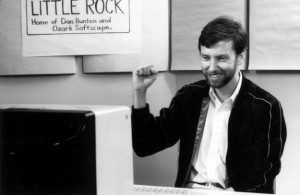
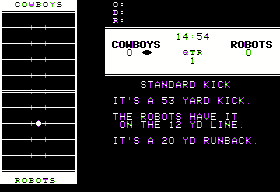
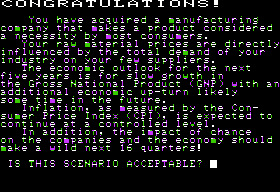
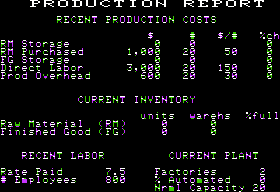
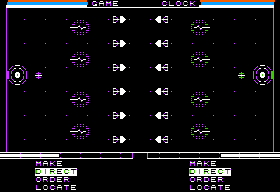
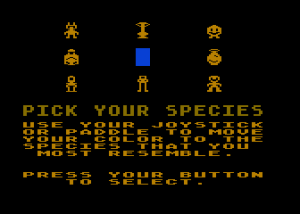

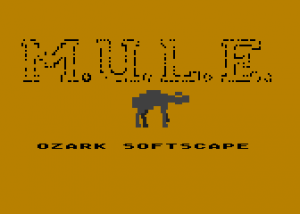
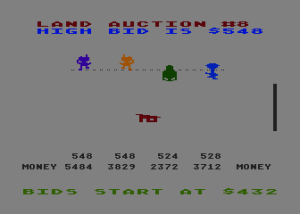
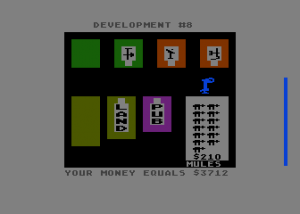
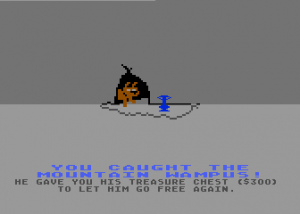
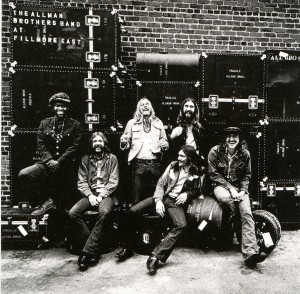
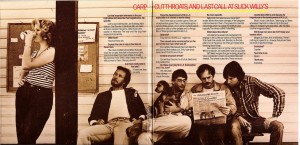










Keith Palmer
February 13, 2013 at 1:25 am
I knew enough about M.U.L.E. from hearsay that I thought of it on first hearing about Paul O’Brian’s work of interactive fiction LASH, although in the end the resemblances beyond four-letter acronyms for their titles seem very subtle if they’re there at all. If that comment was pointless, I suppose I can at least say your description of the game is another spur to add an Atari 800 emulator to my little software collection…
Victor Gijsbers
February 13, 2013 at 11:44 am
I read this article, and I immediately thought: “Ah, that’s where L.A.S.H. is coming from!’ The resemblance seems quite strong to me: (1) L.A.S.H. starts with a robot that is supposed to salvage stuff for his human masters, who may (I can’t recall) have colonised space (or are merely in some small habitable part of what has become a hostile planet?); (2) it then turns into the story of, uh, another kind of robot that is literally put in fields of crops to make an economic profit for a class of capitalist owners.
Keith Palmer
February 13, 2013 at 10:42 pm
Thinking about it I do see your point; when I made my comment I might have just been struck by the difference in the “tone” of the two games, M.U.L.E. seeming cheery and LASH being something different… of course, one effective way to “comment” on something does seem to be to change the tone.
Victor Gijsbers
February 14, 2013 at 8:15 pm
I was especially struck by the place in article where Jimmy wrote about the early development of M.U.L.E.: “The fact that the mules are nevertheless bought and sold like livestock makes this just one more squicky aspect of a very squicky book; it feels uncomfortably like slavery.”
Melvin
February 13, 2013 at 2:47 am
Thus the presence of this B-lister on EA’s roles
I think you mean “rolls”.
Jimmy Maher
February 13, 2013 at 8:04 am
Thanks!
Sig
February 13, 2013 at 4:11 am
MULE was my first exposure to the C64, our first home computer. I remember the box and the disk, so we must have actually bought it; this was not always the case for beloved games from my childhood. I couldn’t have been more than 7 or 8, but I remember it being simple enough that I could play it with the bigger kids, although I’m sure I was dreadful at it. Many positive memories for this one.
christian
February 13, 2013 at 6:02 am
I’m a big fan of M.U.L.E. too, kept playing it on the C64, but was never able to get four players together for a real multiplayer session.
But rejoice! Ozark Softscape seems to have officially licensed the title to another company who is now working on a faithful remake: M.U.L.E. Returns.
It should have been released months ago and seems to be constantly done soon. I’m really looking forward to it…
Eeeyore
February 13, 2013 at 3:53 pm
Shame on the author for relegating Dani Bunten’s transsexuality to a dismissive footnote. You don’t think the concept that Dani was a woman living as a man, trying to compete in an industry that was so male oriented they had to put a babe in the company profile picture as “an element of additional interest” had anything to do with why M.U.L.E. is the game that it is despite market pressures at the time? Wake up.
Jimmy Maher
February 13, 2013 at 4:10 pm
I think we can best respect Dani by treating her as a unique human being, not as a sort of generic poster child for transsexual rights, a role she explicitly rejected in her later years. Nor do I think she would agree with your characterization of Dan as a “woman living as a man.” After the operation she expressed regret, saying she could have found ways to balance her feminine and masculine sides without making the irreversible choice she did. I didn’t delve into the psycho-sexual makeup of Richard Garriott or Bill Budge or any of the other noted designers I’ve profiled. Why should I treat this one any differently if it doesn’t bear directly on the game in question? Is a transsexual allowed only to be a transsexual, above every other facet of her identity?
Ah, but you claim it DOES bear on the game in question? Okay… in what way exactly do you see Dan’s being “a woman living as a man” reflected in M.U.L.E.? Please be sure to respond with specifics, not vague generalities.
Eeyore
February 13, 2013 at 6:16 pm
You are the one who wrote an article that appears to credit at least part of what M.U.L.E. is to who Dani Bunten was. Do you really think that issues of gender identity have absolutely no bearing on personal identity?
I agree that even Dani Bunten would have denied that gender was central or primary to her work. All I’m saying is that it deserves at least as much mention in the body of this article as the fact that she was a bicycling enthusiast.
Andrew
February 13, 2013 at 11:09 pm
Someone linked to this on twitter and now I’m totally hooked on the whole site. Great work! So far I have found every article fascinating. I hope you do one about Archon!
As an aside, the decision whether to feature the transgender issue is up to you. Personally I don’t see how it affects the game or would benefit the article. I knew nothing of MULE or its creator and when the TG postscript came up I did a doubletake. It may be interesting, it may be important, but it doesn’t connect with the article.
matt w
February 14, 2013 at 3:33 am
This is I think the definitive take on the shortcomings of Monopoly.
And I agree with Eeyore; hard to see how you can write about Bunten’s personality at all without discussing her gender identity. Not to mention that it has directly affected the legacy of M.U.L.E.; the Alpha Colony Kickstarter referred to Bunten as “Dan Bunten” at the insistence of her family (and one of her regrets was that after the operation her family cut her off), and fell short of its total by $28. As Anna Anthropy (I think) said, Do you think they alienated $28 worth of supporters by insisting on “Dan Bunten”? The family’s (and thus estate’s) very insistence on referring to Bunten as a man makes it impossible to avoid the question as part of the story, I think.
Jimmy Maher
February 14, 2013 at 6:44 am
Okay… there are obviously different opinions on this, but I’ll try once more to explain my point of view.
I refer to Bunten as “Dan” throughout the article not in an effort to convey any sort of disapproval or disrespect for her eventual choice, but simply because at that time she WAS a man. This is no different from the way I refer to the company that eventually became Sierra as On-Line Systems for many, many articles.
Alpha Colony fell short by $28 because the creator realized he couldn’t do the game justice with $50,000, and WANTED to fail: http://www.rockpapershotgun.com/2012/12/04/alpha-colony-kickstarter-fails-by-28-dev-is-sorta-glad/. In our rush to show how supportive we are of transgender rights, let’s not find tragedies where they don’t exist. We could just as easily flip the question on its head, and ask how many people who contributed to the Kickstarter would have been so offended by Bunten’s choice that they wouldn’t have contributed had they known her full story. Hopefully one thing we all can agree on is that there’s still lots and lots of ugly prejudice out there.
On the subject of bicycles… That little anecdote was deployed not because it has any importance in itself, but to illustrate Bunten’s idealism, which is central to his work on M.U.L.E. and other games for reasons I spend much of the article elaborating in detail. I would have thought this was clear from any reasonably careful reading of the article. Eeyore tells me that gender, on the other hand, is not “central or primary to her work.” So, if I am not required to discuss the sexuality and/or gender identity of every designer I profile, why should I write about it in this case?
Finally, we come to the old saw about how Bunten must have been suffering when EA demanded that a woman be added to the jacket photo, etc. I see that sentiment bandied around a lot when discussions of Bunten come up, and I frankly find it offensive. Dani never publicly stated what she was or wasn’t feeling at that time. I don’t think it’s up to me to presume. We know that Bunten was married three times and had three children during his life as a man. It seems his sexuality may have been… complicated. I think it’s more than enough to leave it at that, and not try to indulge in further psychoanalysis drawn from conventional transgender talking points about what it’s like to live as the wrong sex, etc. One thing I’ve learned as a writer is that when you just don’t know it’s best to just keep quiet. Another thing I’ve learned is to treat people as individuals, not representatives of their class, race, or sexual makeup — unless they have chosen to be, of course, which Bunten did not.
I thought it would be really nice to write an article about Bunten as a great game designer that didn’t devolve into a discussion of her sexuality and gender identity. This long comment means I’ve maybe to some extent failed — but that was the intention. :) If it helps at all, know that I’m fascinated by Bunten’s career, and plan to continue to follow it as we move forward. Should this blog someday make it to 1993 or thereabouts, I will address Bunten’s choice in the body of an article, I promise, and try to treat it with the respect and gravity it deserves.
Eeyore
February 14, 2013 at 1:54 pm
The credibility of this goes in the toilet about halfway through where you misquote me to make your point.
Jimmy Maher
February 14, 2013 at 2:04 pm
You refer to my substitution of the word “important” for “primary”? If so, sorry about that. I corrected it in the original comment. I’m not sure it’s a big enough change to constitute grounds for a charge of deliberate misquoting, but I can see where it changes the shade of meaning a bit.
matt w
February 14, 2013 at 7:37 pm
Hi Jimmy,
I’m not objecting to your decision to call Bunten “Dan” because that’s what he was known as at the time. (Nor am I not objecting — I just don’t think it’s my place to make a judgment on this.) I’m not even saying that you need to say a lot more about Bunten’s transgender identity in the article, though it seems potentially as relevant to his career as Bill Budge’s luxurious head of hair and striking eyes. (Yes, I know that you mention a picture of him.) But what you do say about it does come across as dismissive. Consider the difference between putting a footnote at the beginning saying “Bunten later had sexual reassignment surgery and became known as Danielle Bunten Berry, but at the time was known as Dan Bunten, so that’s the name I’ll use. And I won’t speculate on how Bunten’s gender identity affected M.U.L.E., because I don’t think it’s my place to” and “it didn’t seem particularly relevant to this article. You can find lots more about that elsewhere if you’re interested.” One comes across as “I personally don’t have anything to say about this” and one comes across as “I think this is unworthy of discussion.”
As for Alpha Colony, yeah, I know that story, but it’s still part of the story that Bunten’s family (and thus estate) feels so strongly about denying his transgender status that they’re making future development of the IP conditional on referring to “Dan Bunten.” Doesn’t that in itself bring issues of transgenderism into the story of the game as it’s developed?
I’m not saying every discussion of Bunten needs to turn into an essay on gender issues, just to get you to look at the way you did treat that issue with fresh eyes and see how it comes across as more hostile than it needs to be.
Jimmy Maher
February 14, 2013 at 8:08 pm
I’m sorry, but I just don’t see how saying I don’t find Bunten’s transgenderism relevant to this article can be equated with saying I find it completely unworthy of discussion. Nor do I find whatever moves Bunten’s estate has been making — your comment was literally the first I heard about that — relevant to this article, since the article actually says virtually nothing about M.U.L.E. since its initial release and commercial disappointment. I don’t, for instance, even mention Alpha Colony in the body of the article, nor any of the other authorized or unauthorized remakes (beyond a note that they exist for those looking to play the game with more modern interface and graphics), nor for that matter the version Bunten herself worked on briefly for the Sega system right after her change. I’ll perhaps get to all of that if the blog gets that far someday, but, a quick blurb about M.U.L.E.’s stellar reputation with some established game designers aside, it didn’t happen in this article by intention. Surely 6000 words is enough for one post. :)
And you kind of continue to move the goal posts on me. ;) Yesterday you said I needed to discuss her gender identity in order to write about her personality at all. Today you say it’s okay that I didn’t, but I should have handled the omission more diplomatically.
But as I’m sure you know I respect your point of view. I’ll add a little note to the main article telling those interested to look to the comments for more of my thoughts and those of others on this issue.
matt w
February 16, 2013 at 8:45 pm
Fair enough about moving the goalposts, though at least I think I moved them toward you rather than away from you. Anyway, I appreciate the note.
What I think makes it especially fraught is that you can’t refer to Bunten at all without implicitly taking a position. You could write an article about, say, Jerry Lawson (who I just heard of a few months ago) without mentioning that he was black, but with Bunten the very use of a name or a pronoun is fraught.
Dave Fancella
April 4, 2018 at 2:04 pm
Well, speaking as someone of somewhat ambiguous gender identity, the only I’ll say about what you wrote is that I agree that you should have mentioned at the beginning something about Bunten being transgender and your deliberate choice to use “Dan” as the name and “he/him” as pronouns because that’s what he was using at the time of MULE.
For the rest of us, Dan/Dani Bunten stands as sort of a tragic figure, really. I’m not even sure what the right pronouns are, since he came out later saying the GRS wasn’t such a great choice after all. But even so, it has absolutely no bearing on MULE.
Here’s the thing: For Bunten’s gender identity to impact what is essentially an economic simulation would be to say that gender identity impacts a person’s view on economics. And, well, one thing that psychologists have proven time and time again is that gender identity only impacts a few limited areas of thought, and politics/economics/religion aren’t any of them. So Bunten’s gender identity had absolutely nothing to do with the development of MULE, and choosing to use the name he was using during this time period is just as reasonable as your articles discussion Activision and their stupid name change using the name the company had at the time of the events being discussed. It’s worth noting that when you write about Mediagenic, you don’t always point out that they were just a yuppy Activision phase of development. You probably should, since it turns them into a disconnected company in articles where there’s no Activision presence otherwise. ;)
Anyway, after reading this article, I’m starting to consider writing a MULE knock-off as a game when I get my stupid game network library working. Also, putting an Atari 800 emulator on the living room computer so my kids and I can play it with four joysticks (we’ll have to use two xbox controllers and then map the other two joysticks to the wireless keyboard, though). We played the C64 version emulated, but found the joystick passing to the third player to be a pain. I genuinely thought MULE had been developed for the C64 originally, so I didn’t even know to find the Atari 800 version. Thanks for that. :)
Alan Watson
May 3, 2014 at 12:59 pm
I don’t recall EA having any to do with having a girl in the album photo. Just seemed to fit the mood at the time. There’s a dog in the shot. And no one is making comments about it.
Michael Davis
January 6, 2015 at 12:42 am
“I would have thought this was clear from any reasonably careful reading of the article.”
It is.
Chuck Tinsley
June 8, 2015 at 6:38 pm
I know I’m a couple of years later on this discussion, but I first wanted to thank you for your article on this game. I just found your blog a couple of weeks ago, and I was very happy to see that you had chosen to write such a comprehensive article on a game that became one of my all time favorites to play, even into the nineties on my battered but still barely functioning Commodore 64.
I won’t go into all the transgender discussion that has been so thoroughly beaten to death in the previous comments. The only thing I wanted to mention is that the people who seem to believe that, just because he was transgender, he was attracted to men prior to the change, don’t know what they are talking about according to Dani Bunten herself. It has been several years since I read her website (it probably isn’t even around anymore except on archive.org), but I believe that she mentioned that she had no intention of dating men after the surgery. She had always been attracted to women when she was living as a man, and she expected to be a lesbian after the change. Within a year or so after the change, she was surprised to learn that she was becoming attracted to men, and her attraction to women was fading. This is apparently a fairly common thing that happens after gender reassignment. I have seen it happen with a friend of mine who went through it.
And I agree, none of this had anything to do with your article. It was a well written and passionate homage to a game you obviously love, and with good reason. Thanks again for this article and for this blog.
Mark Terrano
February 14, 2013 at 11:44 am
Wow, fantastic article – when I started it I didn’t realize it would be so deep, so well researched, and dense with detail. I was a huge fan of all of Dan’s early strategy games and changed my career after playing Modem Wars and being hooked on multi-player’s potential. I had a chat with Dani at an early GDC – maybe 1995 and she said that “after my change I just didn’t have inclination to design strategy – the social aspects came naturally but maybe for me strategy design is hormonal”. One of my all-time favorite designers, her games have had a substantial influence in the way I make games.
Fantastic job Jimmy.
Greg Howard
February 15, 2013 at 3:09 am
A truly wonderful piece, Jimmy. let me get back to the real point of it: M.U.L.E was a seminal work that changed the development path of video games, and continues to influence game design today.
I am one of the 30,000. I bought M.U.L.E. when it first came out, and played for 1000’s of hours on my Atari 800. My brother and two of our best friends would often begin in late afternoon, end finally quit playing when the sun started peeking through the shades the following morning. For months we were as cutthroat as players are these days when playing MMOGs, but eventually we settled on a more cooperative approach: We worked to get the highest total colony score we could manage, rather than sweat which of us ended with the highest individual score.
My fascination with M.U.L.E. never subsided, and 3 years ago (now long married, with teenage children) I bought an ATARI 800, with four original analog joysticks and the original cartridge for the game, and convinced my 13 year old daughter & 12 year old son to give it a try on our huge living room TV. (Okay, “convinced” may be a bit soft. I threatened them.)
My wife thinks the game is “very nice”, my daughter finds it “cute, but fun”, and my son has fallen in love with it to the extent that now he’s antsy/angry that “M.U.L.E. Returns” still isn’t available for iOS and Android…and he wants to write angry emails expressing his displeasure.
As an aging geek who has seen the entire history of computer gaming evolve, from text-to-printer games we played on mainframes in the 70’s, to Pong, to arcade & primitive console games; from Sierra’s popularization of humor (Leisure Suit Larry) and horror (Phantasmagoria) to LucasArts’ visual puzzle wonders (Grim Fandango) all the way to spectacular 2012 visions like “Dishonored” (which I love), I have seen it all and played a lot.
We have a Wii, an Xbox 360, a PS3, iPads and, of course, computers. We play games of all types on all platforms. Yet for me, M.U.L.E. remains one of my top five games of all time, and I still play it regularly. Higher praise I cannot give.
Wholly
February 17, 2013 at 2:25 am
Jimmy,
I think you handled the issue on Dan just like he would have wanted it. At the time of this gane’s development there is nothing that the future has any bearing.
Not everything has to find great meaning in Dan/Dani’s personal decision. And his struggles really don’t have to have any bearing on everything in his life. All of us have challenges and we all question identity and meaning and importance. I do not believe that the achievement of M.U.L.E. and everything else done by Dan/DanI be tainted or minimised or worse, made subservient, to a single decision in Dan’s life.
Sometimes a game is just a game. But M.U.L.E. was magical.
Oliver
February 17, 2013 at 4:40 pm
Thank you for that blog post, I enjoyed it very much. I still hope for a book series to materialize, a seminal discussion of computer/gaming history.
Thanks again and keep up the good work!
J Chastain
May 24, 2013 at 3:25 am
What you do if you want to write an article about Dani Buten is you write an article about Dani Buten. The most fundamental bigotry in this piece and in your subsequent comments is that you act like calling her Dani and using her preferred pronouns is a “discussion” of her identity that transforms the entire piece into one on “trans stuff.” That transformation is happening for you alone, inside your mind, where the rest of us don’t see it. What you’ve told us is that you feel entitled to deconstruct her life and her identity and decide, for yourself, which bits are or aren’t valid. You’ve told us that you think Richard Garriott and Bill Budge are worthy of being called by their own names and you have judged that Dani is not.
Anyway, the tone and the language of the trans talk in these comments is some seriously clueless 1970s TV movie shit and it’s actually possible to both cling to your old video game obsessions and engage with actual living human beings (even the ones you haven’t tried to understand) but w/e, I just wanted to point out how lame this all is and I don’t want to mislead you into thinking we’re going to have a “dialogue” now.
mike russo
May 27, 2015 at 1:11 am
It’s a great article, marred by some unfortunate comments from many holier than thou people such as you. Having known a few trans people in my life, I concur that everyone I’ve known has always wanted to be treated individually and not as a stereotype or representative of all other trans peoples and I think that is what the author has respected.
Giuseppe
June 21, 2013 at 8:54 pm
The amount of sanctimoniousness in a few of these comments is both amusing and a little bit scary.
mooninite
June 23, 2013 at 2:37 am
First of all, thanks for writing this blog. I’ve really enjoyed reading.
With regard to Dan/Dani’s sex change, I think it deserves to be mentioned here. The justification that it’s irrelevant to what was going on in 1983 seems weak. You have referred several times to Richard Garriot’s trip into space, which didn’t happen until 2007. And there was a long discussion of Czeckoslovokia in the 1940s and early postwar period when discussing Siro-Tech.
The truth is, it is the human interest aspect of these stories that makes them interesting. It’s a chance to see the people behind the bits and bytes. I am not saying you need to beat people over the head with the sex change in every article about Ozark. I also think it’s fine to use “Dan” when talking about 1983. But this is the first time you’re introducing Dan/Dani, so I think it belongs there.
Kate Willaert
April 12, 2014 at 4:58 am
Wow, they really took you to task in the comments here.
I think maybe a better way to have footnoted the sex change would’ve been to mention that Dan later became Dani, and that you’ve referred to Dan with male pronouns not to be disrespectful, because that was Dani’s own approach to talking about her past:
“Although to some it may sound bizarre using ‘he’ to refer to myself in the previous gender, it actually feels more accurate than any other alternative (and it’s shorter than ‘the previous owner of this body’ which I also occasionally use).”
And I think it’s completely valid to only mention the gender issues in passing, since it’d likely require an entire article to do justice to how complex Dani’s gender issues were, in combination with her internalized sexism (so willing to throw herself into this gender role, she convinced herself that “I’m not as good a programmer as he was.” I guess she was unaware that the first programmers were women).
Kate Willaert
April 12, 2014 at 5:01 am
I forgot to include the links where I found those quotes:
https://web.archive.org/web/20010418110810/http://www.mpath.com/dani/personal/changes/index.html
https://web.archive.org/web/20010713013404/http://www.mpath.com/dani/personal/biz/interview.htm
Jimmy Maher
April 13, 2014 at 7:14 am
Thanks for the thoughtful take on this and the support. I now realize I didn’t handle this as well as I might have, although my intention was never to dismiss or belittle and I still remain annoyed by people who insist on making Dani Bunten Berry’s achievements as a game designer essentially a footnote to her transgenderism. I elaborated further in my article on Ozark Softscape’s follow-up to M.U.L.E., Seven Cities of Gold: http://www.filfre.net/2013/08/seven-cities-of-gold.
retcongender
November 8, 2016 at 9:22 am
With a couple of years delay, I though I’d wade into this one, being in a relatively unique situation to comment on it. Asa transgendered person myself, I have no issue at all with you treating Dani’s situation as you have – I would even say that it is as close to the perfect way for handling the situation as possible, because any approach is compromised by our society’s insistence on gender being binary and immutable.
I have appreciated throughout your articles that you often use the female version of third person pronouns, and think it is utterly ridiculous for people to take you to task on this. Your heart seems oh so clearly in the right place.
Jimmy Maher
November 8, 2016 at 9:44 am
Thank you! That means a lot.
Gideon Marcus
February 5, 2017 at 7:51 pm
Agreed. I noticed (and appreciated) that, too.
I pointed out that picture of Dani with a beard to my wife and simply said, “Hey look! That’s what Dani Bunten used to look like!”
MULE is one of the greatest games ever, and I maintain an Atari 800 with four joysticks set up to play on a moment’s notice. I don’t have trouble finding players…
Name Withheld
November 4, 2018 at 10:57 pm
It’s a great article about a great game and unless you wanted an equally long treatise on Dan/i Bunten’s sexuality, which in any event is probably not within your field of expertise, then you made absolutely the right decision and I don’t think you should be discouraged by critics who seem to place their own view of and feelings about that sexuality over and above the rightful focus of the article and perhaps even Bunten and family’s own feelings on the matter.
Alan Watson
May 3, 2014 at 1:17 pm
Thanks for your very nice article. I worked with Dan from Cytron Masters through Command HQ. His sexual interests seemed normal and certainly had nothing to do with our games. We parted after Command HQ because of differences about games credits and money, but remained friendly. I was as surprised as anyone to learn about his sex change later on. I did some animation for Dani after her game Global Conquest. She had a new group of programmers by then and seemed more interested in consulting then game development.
Jimmy Maher
May 4, 2014 at 7:25 am
Thanks so much for stopping by! Very glad to hear you liked the article.
Soh Kam Yung
August 22, 2015 at 1:34 am
This just popped up in my social media feed. An official adaptation of M.U.L.E. as a board game. [ https://www.boardgamegeek.com/blogpost/45059/mule-board-game-debuting-lautapelitfi-spiel-2015 ]. Fun times.
Adam
March 26, 2017 at 7:43 pm
I bought this board game for my M.U.L.E. loving father-in-law. It’s not fun, although it is true to the game. It’s too fiddly and too random to be a good modern board game. The article talks about how M.U.L.E. benefited from being a video game because it could perform more complicated calculations behind the scenes, which I think is true.
Jason Kankiewicz
December 8, 2016 at 12:49 am
“Particularly wonderful is his detailed history of Seven Cities of Gold‘s development in the August 1984 issue.”
If you mean his “DISPATCHES: Seven Cities of Gold Designer Notes” article then it was actually published in the October 1984 issue of Computer Gaming World.
Jimmy Maher
December 8, 2016 at 8:19 am
Assuming that this comment should have been attached to the Seven Cities of Gold article… thanks!
tedder
December 31, 2017 at 2:31 am
Repeated duplicative repetition in the same para:
“The game was designed to always have four players, with the seats of any absent humans being filled by computer opponents. … Even more importantly, the computer provides one or two reasonably credible additional players to round out a game if you can’t get four humans together….”
Jimmy Maher
January 1, 2018 at 12:22 pm
Thanks!
Scott
July 11, 2018 at 5:24 pm
What a fantastically researched article about one of my favorite computer games of all time and how it came to be!
Anonymous
June 16, 2019 at 1:15 am
Great article on a great game. Ignore the comments from neo-liberal evangelicals who make insane demands.
SavoniaX
August 25, 2019 at 6:34 am
The Artists – Episode 5 “Come Together: The Life & Times of Dani Bunten-Berry” is an interesting documentary about Dani Bunten. CBC has it if you’re in Canada [https://watch.cbc.ca/season/the-artists/season-1/6ec08750-b8fd-4841-9d62-5d05760af9be]. Topic is streaming in the US [https://www.topic.com/the-artists/come-together].
Mark Ormston
November 27, 2019 at 7:37 am
Great history information for the game. This is my favorite 8-bit game, and it’s sad that it never sold very well.
I wish I knew about this site before I made my own contribution to M.U.L.E. on YouTube: https://www.youtube.com/watch?v=lgQBOuCM844
Edwin van den Oosterkamp
July 31, 2020 at 1:18 pm
Great blog! Thoroughly enjoying it.
One small comment – the link to “grognard” currently leads to a “Page not found” error.
Ben
November 12, 2020 at 6:14 pm
state of Arkansas -> State of Arkansas
is is a herd -> is a herd
Jimmy Maher
November 14, 2020 at 10:21 am
Thanks!
Marc Niegowski
January 4, 2021 at 7:14 pm
Another great post what a large number of controversial responses it drew!
Typo; I think “. . . take advance of economies of scale to produce more. . .”
Should be “. . . take advantage of economies of scale to produce more. . .”
Jimmy Maher
January 6, 2021 at 2:11 pm
Thanks!
Will Moczarski
March 13, 2021 at 7:50 am
it would have to use a few of the feature of that machine
-> features
Jimmy Maher
March 15, 2021 at 8:40 am
Thanks!
Funky
January 6, 2022 at 4:58 am
MULE is and remains one of the very few computer games that is still playable nearly three decades later. Inspired by a friend—the same who shared this blog post—I downloaded VICE (a c64 emulator). I did not have an Atari so I was introduced to MULE through the Commodore 64 version. A wave of nostalgia hit me when I first saw the blue screen interface on the emulator but that was nothing compared to the sound of the rhythmic clomping of mules marching across the screen… truly timeless.
MULE is a game that reminds us we don’t need terabytes of data or teraflops of processing to make something great.
Thank you for writing about one of my all-time favorite games.
vykromond
August 25, 2023 at 9:49 pm
“With their EA advantage” -> advance?
Jimmy Maher
August 28, 2023 at 9:05 am
Yes. Thanks!
Busca
November 12, 2023 at 8:38 am
“[H]e wrote a simple four-player auction game called Wheeler Dealers. He designed a simple hardware gadget to let all four players bid at once. (The details of how this worked, as well as the game software, unfortunately appear to be lost to history.)”
This recent post on mastodon by ‘A2_Canada’ with pictures of gameplay and a tape says that Wheeler Dealers was recovered, made playable and archived.
Doesn’t say if it’s publicly available and where or will be, though. Maybe someone on mastodon wants to ask?
Mark Botner
December 18, 2023 at 2:15 am
Hi Jimmy,
I stumbled onto your web page while reading about Dan Bunten – whom I worked for many years ago in LittleRock on several games and have enjoyed reading about him here.
I’ve recently been in contact with his daughter and she gave me one of his trophies, of which I restored and will send you a picture if I can send it to you somehow. – let me know.
Regards,
Mark Botner
Jimmy Maher
December 18, 2023 at 11:18 am
There’s a email link in the right column on the desktop version of this site. ;)
You might consider donating the trophy, if you don’t mind parting with it, to the Strong Museum of Play. They have a large Dani Bunten Berry archive there already, donated by her family, and I’m sure they’d love another piece for the collection.
_RGTech
December 19, 2023 at 5:14 am
“a six-sided die” should also be a dice, hm?
(I’m surprised that some of these typos managed to survive for over 10 years now, despite the many many commenters before me…)
Jimmy Maher
December 19, 2023 at 6:31 am
No. The singular of “dice” is “die.” ;)
Ross
December 19, 2023 at 7:14 pm
Most dictionaries have given up the fight and now define “dice” as both singular and plural. Or worse, define “die” as an archaism for “a single dice”.
Jimmy Maher
December 20, 2023 at 9:04 am
That surprises me. While people constantly get this wrong in spoken English, I could have sworn that most well-edited board-game instruction manuals and the like still get it right.
arcanetrivia
December 21, 2023 at 7:55 pm
Unfortunately it appears that Ross is mostly right. I checked Merriam Webster, American Heritage, and Oxford. American Heritage is the firmest that dice is a plural and die is the singular. OED won’t let me access the full information without paying but the brief result says dice is “properly plural”, implying an acknowledgement that it is also used as a singular even if it’s not purely correct. Merriam Webster treats it as a singular because it gives a plural form in the entry (as it does for mouse, giving mice; in this case both are “dice”) and gives the first definition as a link to the entry for “die”.
Personally I also stick to die/dice and “a dice” sounds wrong to my ear outside of a culinary context.
Ross
December 23, 2023 at 3:38 am
See, the problem is that people who care a LOT about dice would refer to a single one not as “a die” but as “a d6”.
arcanetrivia
December 23, 2023 at 10:55 pm
I mean… I do do that sometimes, lol (assuming the die in question is in fact six-sided).
Jay Smith
July 20, 2024 at 2:16 am
I loved this game so much. I played it with my brothers, my friends, even my parents when I was 13. I thought the inner sleeve game designers really were rockstars. I hear the theme in my head, and can visualize every screen of gameplay. Brilliant in every way, this game was inspiration for so many designers.